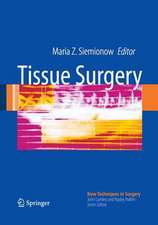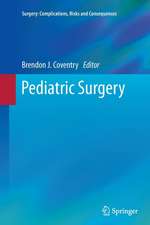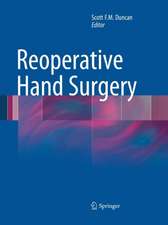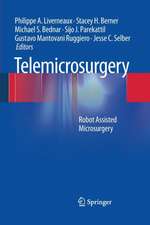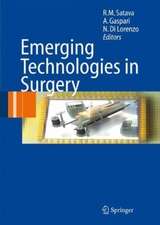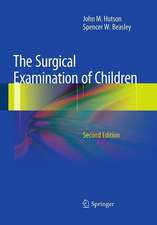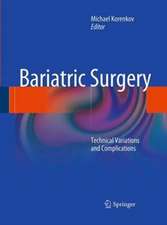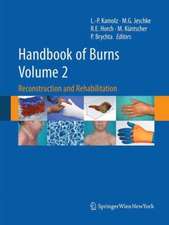Frontofacial Monobloc Advancement with Internal Distraction: Tactics and Strategy in Faciocraniosynostosis
Autor Eric Arnaud, Giovanna Paternoster, Roman Hossein Khonsari, Samer E. Haberen Limba Engleză Hardback – 3 feb 2023
Technical refinements and strategic planning have made it almost a routine procedure at the French Reference Center for Craniosynostosis and Craniofacial Malformations.
This easy-to-consult, well illustrated book includes technical tips and indications for its use in Crouzon, Pfeiffer and Apert syndromes. It also provides a protocol, including a proposed management algorithm for faciocraniosynostosis. As such, it will appeal to craniofacial surgeons, especially those at large craniofacial centers.
| Toate formatele și edițiile | Preț | Express |
|---|---|---|
| Paperback (1) | 786.33 lei 38-44 zile | |
| Springer International Publishing – 3 feb 2024 | 786.33 lei 38-44 zile | |
| Hardback (1) | 1073.98 lei 17-23 zile | +91.85 lei 4-10 zile |
| Springer International Publishing – 3 feb 2023 | 1073.98 lei 17-23 zile | +91.85 lei 4-10 zile |
Preț: 1073.98 lei
Preț vechi: 1130.50 lei
-5% Nou
Puncte Express: 1611
Preț estimativ în valută:
205.57€ • 223.37$ • 172.79£
205.57€ • 223.37$ • 172.79£
Carte disponibilă
Livrare economică 27 martie-02 aprilie
Livrare express 14-20 martie pentru 101.84 lei
Preluare comenzi: 021 569.72.76
Specificații
ISBN-13: 9783031075735
ISBN-10: 3031075730
Pagini: 320
Ilustrații: XVII, 320 p. 332 illus., 294 illus. in color.
Dimensiuni: 210 x 279 mm
Greutate: 1.18 kg
Ediția:1st ed. 2023
Editura: Springer International Publishing
Colecția Springer
Locul publicării:Cham, Switzerland
ISBN-10: 3031075730
Pagini: 320
Ilustrații: XVII, 320 p. 332 illus., 294 illus. in color.
Dimensiuni: 210 x 279 mm
Greutate: 1.18 kg
Ediția:1st ed. 2023
Editura: Springer International Publishing
Colecția Springer
Locul publicării:Cham, Switzerland
Cuprins
Front Matter.- Introduction: A simplified strategy for complex conditions.- Intra-cranial pressure management and posterior vault distraction.- Standardization of Fronto Facial Monobloc Advancement (FFMBA) developed in necker.- Post-operative analysis after fronto facial monobloc advancement (FFMBA).- Secondary Le Fort III facial advancement after primary fronto-facial monobloc advancement: effects on sleep apnea syndrome.- Very early monobloc: a procedure for extreme conditions with transfacial external traction and internal distraction.- Dental consequences of FFMBA.- Tracheostomy management: how FFMBA contributes to the removal.- Complications after frontofacial monobloc advancement.- Treatment strategies in faciocraniosynostosis.- Aesthetic refinements in faciocraniosynostosis surgery.- Conclusions.
Notă biografică
Eric Arnaud completed his plastic surgery training after being board-certified in general surgery. He was “Chef de Clinique” at the Plastic Surgery Unit of Saint-Louis Hospital in Paris until 1998.
He developed a special interest in craniofacial surgery, and trained under Daniel Marchac and Dominique Renier in Paris, as well as Fernando Ortiz-Monasterio in Mexico 1993, and Ken Salyer in Dallas. He joined the craniofacial team in Paris in 1999, and has been the Co-director of the Craniofacial Unit at Hopital Necker Enfants Malades in Paris since 2008.
Eric Arnaud is the author or co-author of more than 140 national and international publications, and editor of three books on plastic surgery, specifically on techniques related to distraction osteogenesis. He has presented more than 150 communications at various international meetings. Dr. Arnaud has been a member of the International Society of Craniofacial Surgery since 1999, and is a member of the Brazilian Societyof Craniofacial Surgery and the Argentinian Society of Plastic Surgery. He served as Secretary of the European Society of Craniofacial Surgery (ESCFS) and as its President (2011-2013). More recently he was President (2017-2019) of the International Society of Craniofacial Surgery and organized the XVIIIth International Congress in Paris in September 2019. Eric Arnaud is an expert on the management of complex faciocraniosynostotic conditions.
Roman Hossein Khonsari completed general surgery and maxillofacial surgery residencies in Nantes and Paris, where he trained with Jean Delaire, Jacques-Marie Mercier, Jean-Claude Talmant and Pierre Corre, with a focus on cleft repair and orthognathic surgery. He developed an early interest for craniofacial surgery while attending procedures as a medical student at the Necker Craniofacial Unit with Daniel Marchac, Dominique Renier and Eric Arnaud. He completed a craniofacial fellowship at Great Ormond St. Hospital in London in 2012 and a PhD in craniofacial development at King's College London in 2013. He was then appointed assistant professor ('chef de clinique') in maxillofacial surgery at Pitié-Salpêtrière in 2013 and Necker - Enfants Malades University Hospitals in 2015. Since November 2021, he is consultant maxillofacial surgeon at Necker and professor of surgery at the Faculty of Medicine, University of Paris. He is the head of the 'Craniofacial Growth and Form' laboratory, dedicated to the study of pattern formation and growth processes in the head and neck region. He is a member of the International Society of Craniofacial Surgery.
Samer Elia Haber is a plastic surgeon trained in Beirut and in Paris and having completed a craniofacial surgery fellowship in Ann Arbor, Michigan. He joined the Necker craniofacial team led by Eric Arnaud in 2016. He is a member of the French Society of Plastic Surgeons and the Lebanese Society of Plastic Surgeons, and he holds the European Board of Plastic Surgery. He is Assistant Professor of plastic surgery in a joint position at the Pediatric Neurosurgery Department and the Plastic and Maxillofacial Surgery Department at Necker Hospital in Paris.
Eric Arnaud is the author or co-author of more than 140 national and international publications, and editor of three books on plastic surgery, specifically on techniques related to distraction osteogenesis. He has presented more than 150 communications at various international meetings. Dr. Arnaud has been a member of the International Society of Craniofacial Surgery since 1999, and is a member of the Brazilian Societyof Craniofacial Surgery and the Argentinian Society of Plastic Surgery. He served as Secretary of the European Society of Craniofacial Surgery (ESCFS) and as its President (2011-2013). More recently he was President (2017-2019) of the International Society of Craniofacial Surgery and organized the XVIIIth International Congress in Paris in September 2019. Eric Arnaud is an expert on the management of complex faciocraniosynostotic conditions.
Roman Hossein Khonsari completed general surgery and maxillofacial surgery residencies in Nantes and Paris, where he trained with Jean Delaire, Jacques-Marie Mercier, Jean-Claude Talmant and Pierre Corre, with a focus on cleft repair and orthognathic surgery. He developed an early interest for craniofacial surgery while attending procedures as a medical student at the Necker Craniofacial Unit with Daniel Marchac, Dominique Renier and Eric Arnaud. He completed a craniofacial fellowship at Great Ormond St. Hospital in London in 2012 and a PhD in craniofacial development at King's College London in 2013. He was then appointed assistant professor ('chef de clinique') in maxillofacial surgery at Pitié-Salpêtrière in 2013 and Necker - Enfants Malades University Hospitals in 2015. Since November 2021, he is consultant maxillofacial surgeon at Necker and professor of surgery at the Faculty of Medicine, University of Paris. He is the head of the 'Craniofacial Growth and Form' laboratory, dedicated to the study of pattern formation and growth processes in the head and neck region. He is a member of the International Society of Craniofacial Surgery.
Samer Elia Haber is a plastic surgeon trained in Beirut and in Paris and having completed a craniofacial surgery fellowship in Ann Arbor, Michigan. He joined the Necker craniofacial team led by Eric Arnaud in 2016. He is a member of the French Society of Plastic Surgeons and the Lebanese Society of Plastic Surgeons, and he holds the European Board of Plastic Surgery. He is Assistant Professor of plastic surgery in a joint position at the Pediatric Neurosurgery Department and the Plastic and Maxillofacial Surgery Department at Necker Hospital in Paris.
Textul de pe ultima copertă
Based on the experience at one of the largest centers for craniosynostosis and craniofacial malformations, this book reports on the clinical use of a rare technique known as Frontofacial Monobloc Advancement (FFMBA), one of the most rewarding procedures for upper- and mid-face reconstruction in patients with faciocraniosynostosis, a rare craniofacial anomaly associated with premature fusion of multiple cranial sutures presenting with brachycephaly, orbital proptosis, maxillary hypoplasia and anterior crossbite.
Technical refinements and strategic planning have made it almost a routine procedure at the French Reference Center for Craniosynostosis and Craniofacial Malformations.
This easy-to-consult, well illustrated book includes technical tips and indications for its use in Crouzon, Pfeiffer and Apert syndromes. It also provides a protocol, including a proposed management algorithm for faciocraniosynostosis. As such, it will appeal to craniofacial surgeons, especially those at large craniofacial centers.
Technical refinements and strategic planning have made it almost a routine procedure at the French Reference Center for Craniosynostosis and Craniofacial Malformations.
This easy-to-consult, well illustrated book includes technical tips and indications for its use in Crouzon, Pfeiffer and Apert syndromes. It also provides a protocol, including a proposed management algorithm for faciocraniosynostosis. As such, it will appeal to craniofacial surgeons, especially those at large craniofacial centers.
Caracteristici
Highlights the dental consequences following FFMBA Includes a chapter on orbital changes after FFMBA Presents a algorithm for a simplified faciocraniosynostosis strategy

